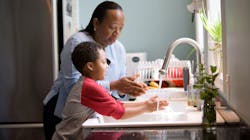CDC reports on transmission of SARS-COV-2 infections in households
Findings from a prospective household study with intensive daily observation for ≥seven consecutive days indicate that transmission of SARS-CoV-2 among household members was frequent from either children or adults, reported the Centers for Disease Control and Prevention (CDC).
Household transmission of SARS-CoV-2 is common and occurs early after illness onset. Persons should self-isolate immediately at the onset of COVID-like symptoms, at the time of testing as a result of a high-risk exposure, or at time of a positive test result, whichever comes first. All household members, including the index case, should wear masks within shared spaces in the household.
Improved understanding of transmission of SARS-CoV-2, the virus that causes COVID-19, within households could aid control measures. However, few studies have systematically characterized the transmission of SARS-CoV-2 in U.S. households. Previously reported transmission rates vary widely, and data on transmission rates from children are limited.
To assess household transmission, a case-ascertained study was conducted in Nashville, Tennessee, and Marshfield, Wisconsin, commencing in April 2020. In this study, index patients were defined as the first household members with COVID-19–compatible symptoms who received a positive SARS-CoV-2 reverse transcription–polymerase chain reaction (RT-PCR) test result, and who lived with at least one other household member.
After enrollment, index patients and household members were trained remotely by study staff members to complete symptom diaries and obtain self-collected specimens, nasal swabs only or nasal swabs and saliva samples, daily for 14 days. For this analysis, specimens from the first seven days were tested for SARS-CoV-2 using CDC RT-PCR protocols. A total of 191 enrolled household contacts of 101 index patients reported having no symptoms on the day of the associated index patient’s illness onset, and among these 191 contacts, 102 had SARS-CoV-2 detected in either nasal or saliva specimens during follow-up, for a secondary infection rate of 53 percent. Among fourteen households in which the index patient was aged <18 years, the secondary infection rate from index patients aged <12 years was 53 percent and from index patients aged 12–17 years was 38 percent.
Approximately 75 percent of secondary infections were identified within five of the index patient’s illness onset, and substantial transmission occurred whether the index patient was an adult or a child. Because household transmission of SARS-CoV-2 is common and can occur rapidly after the index patient’s illness onset, persons should self-isolate immediately at the onset of COVID-like symptoms, at the time of testing as a result of a high risk exposure, or at the time of a positive test result, whichever comes first. Concurrent to isolation, all members of the household should wear a mask when in shared spaces in the household.
The data presented in this report are from an ongoing, CDC-supported study of household transmission of SARS-CoV-2 in Nashville, Tennessee and Marshfield, Wisconsin, and include households enrolled during April–September 2020.
Households were eligible if the index patient had symptom onsetBecause saliva samples are considered an emerging diagnostic approach but are not yet standard for SARS-CoV-2 detection, secondary infection rates were also calculated using positive test results from nasal swab specimens only. To account for household members possibly having been infected when the index case became ill, secondary infections rates were also conservatively calculated excluding household members who had positive test results at enrollment. The study protocol was reviewed and approved by the Vanderbilt University Medical Center’s and Marshfield Clinic Research Institute’s Institutional Review Board and was conducted consistent with applicable federal law and CDC policy.
The median number of household members per bedroom was one. Seventy 69 percent index patients reported spending >four hours in the same room with one or more household members the day before and 40 percent the day after illness onset. Similarly, 40percent of index patients reported sleeping in the same room with one or more household members before illness onset and 30 (30 percent) after illness onset.
Forty percent (41 of 102) of infected household members reported symptoms at the time SARS-CoV-2 was first detected by RT-PCR. During seven days of follow-up, 67 percent (68 of 102) of infected household members reported symptoms, which began a median of four days after the index patient’s illness onset. The rates of symptomatic and asymptomatic laboratory-confirmed SARS-CoV-2 infection among household members was 36 percent and 18 percent, respectively.
In this ongoing prospective study that includes systematic and daily follow-up, transmission of SARS-CoV-2 among household members was common, and secondary infection rates were higher than have been previously reported (1,3–7). Secondary infections occurred rapidly, with approximately 75 percent of infections identified within five days of the index patient’s illness onset. Secondary infection rates were high across all racial/ethnic groups. Substantial transmission occurred whether the index patient was an adult or a child.
An important finding of this study is that fewer than one half of household members with confirmed SARS-CoV-2 infections reported symptoms at the time infection was first detected, and many reported no symptoms throughout seven days of follow-up, underscoring the potential for transmission from asymptomatic secondary contacts and the importance of quarantine. Persons aware of recent close contact with an infected person, such as a household member, should quarantine in their homes and get tested for SARS-CoV-2.
